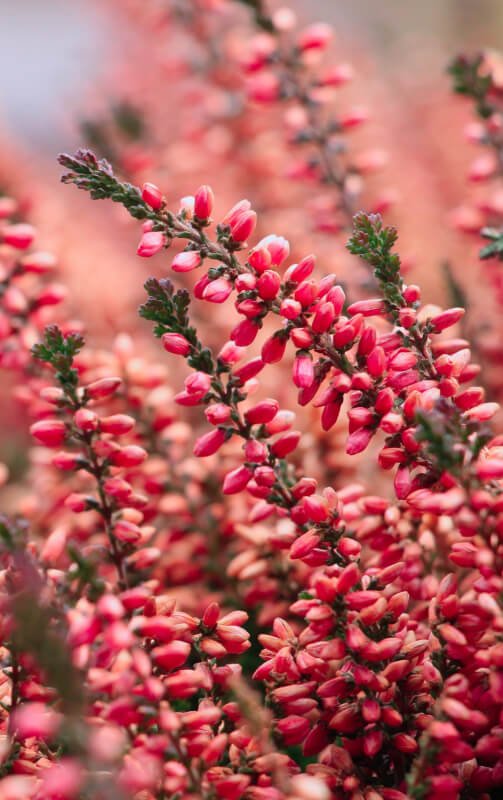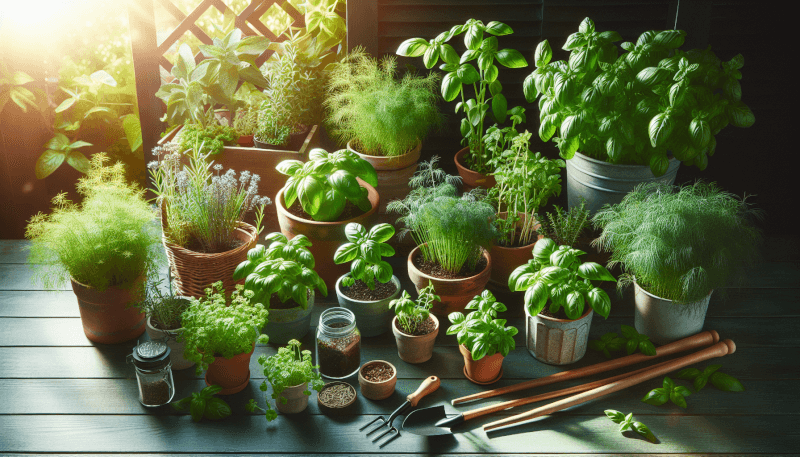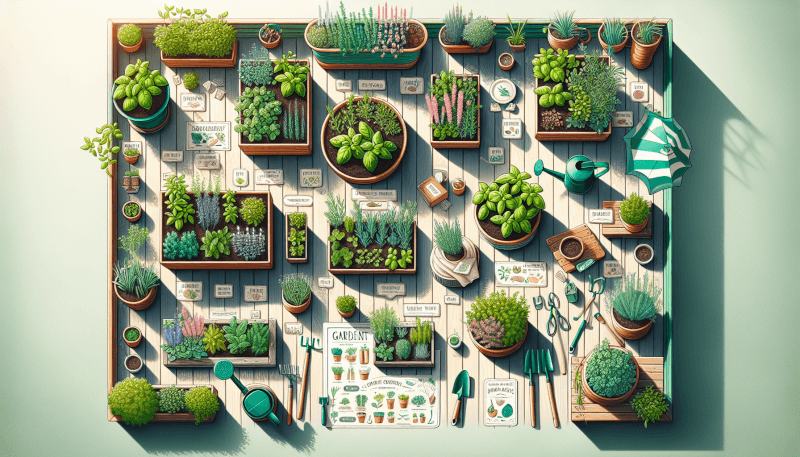Are you eager to start your own herb garden but not sure which plants to choose? Look no further! In this article, we will guide you through the best plants to include in your very own DIY herb garden. Whether you’re a seasoned green thumb or a beginner in the world of gardening, these plants are sure to thrive and bring fresh flavor to your cooking. From aromatic basil to vibrant rosemary, get ready to transform your garden into a bountiful oasis of deliciousness.

Choosing the Right Location
Sun Exposure
When choosing a location for your herb garden, sun exposure is crucial. Most herbs require at least six hours of direct sunlight each day to thrive. Find a spot in your garden or balcony that receives ample sunlight throughout the day. South-facing areas are typically ideal for herb gardens, as they provide maximum sun exposure. However, if you have limited options, east or west-facing areas can also work well. Just make sure to avoid shaded areas as herbs grown in insufficient sunlight may become leggy and produce less flavorful leaves.
Soil Conditions
In order for your herbs to grow healthy and strong, it is essential to consider the soil conditions. Herbs generally prefer well-draining soil with a slightly acidic to neutral pH level. Before planting, ensure that the soil is loose and fertile, as compacted soil can hinder root development. If your soil is heavy or clay-like, you can amend it with organic matter such as compost or aged manure to improve its texture and fertility. Additionally, using a pH testing kit can help you determine if any adjustments are needed to create the most optimal growing environment for your herbs.
Availability of Water
Water is a vital requirement for the successful growth of any plant, and herbs are no exception. When selecting a location for your herb garden, consider the availability of water. Ensure that the area is easily accessible with a nearby water source, such as a hose or watering can. While it’s important to keep the soil consistently moist, be careful not to overwater as herbs generally prefer slightly drier conditions compared to other plants. Adequate drainage is also crucial to prevent waterlogged soil, which can cause root rot. Keep these factors in mind to provide the proper hydration for your herbs.
Starting from Seeds or Transplants
Benefits of Starting from Seeds
Starting your herb garden from seeds can be an exciting and rewarding experience. It allows you to witness the entire growth process, from seed germination to harvesting. Additionally, starting from seeds provides a wide variety of herb varieties to choose from, giving you the opportunity to experiment and discover new flavors. It is also a more cost-effective option as seeds are generally cheaper than buying transplants. Starting from seeds gives you full control over the growing conditions, allowing you to ensure that your herbs are grown organically right from the start.
Benefits of Using Transplants
Using transplants, also known as seedlings or starter plants, can be advantageous for those who prefer a more convenient approach to gardening. Transplants are already established plants that have passed the delicate seedling stage, making them less susceptible to environmental conditions. This option can be ideal if you’re starting your herb garden later in the growing season or if you have limited time and want to jump straight into gardening. Transplants come in different sizes, which means they are ready to be harvested sooner than plants grown from seeds. It allows you to enjoy fresh herbs in a shorter time frame.
Popular Herb Varieties to Start from Seeds
If you decide to start your herb garden from seeds, there are several popular herb varieties to consider. Basil, cilantro, dill, and parsley are commonly started from seeds and are relatively easy to grow. These herbs offer a range of flavors that can enhance various culinary dishes. Additionally, starting these herbs from seeds allows you to experiment with different varieties such as Genovese basil or curly parsley. Sage, thyme, and oregano are also great options to start from seeds, providing aromatic and savory flavors to elevate your cooking.
Popular Herb Varieties to Use Transplants
For those who prefer using transplants, there are also popular herb varieties readily available in plant nurseries or garden centers. Mint, rosemary, and lavender are herbs commonly found as transplants. These herbs can be slightly more challenging to start from seeds, making transplants a convenient choice. Mint offers a refreshing aroma and is well-known for its use in teas and cocktails. Rosemary is a versatile herb that adds a delightful fragrance to various dishes. Lavender, prized for its soothing scent, can also be harvested for culinary purposes. Using transplants allows you to enjoy these herbs sooner and with less effort.
Perennial Herbs for Long-Term Growth
Rosemary
Rosemary is a popular perennial herb with an aromatic fragrance that adds a unique flavor to dishes. It thrives in full sun and well-draining soil. Rosemary requires minimal water once established, making it a low-maintenance herb. It is commonly used in Mediterranean cuisine and complements roasted meats, vegetables, and homemade bread. With proper care, rosemary plants can live for several years, providing a constant supply of fresh herbs.
Thyme
Thyme is a versatile perennial herb that comes in various varieties, including lemon thyme and common thyme. It prefers full sun and well-draining soil. Thyme is widely used in culinary dishes, particularly in Mediterranean and French cuisine. Its earthy and slightly minty flavor enhances roasted meats, soups, and stews. Thyme plants should be pruned regularly to maintain their shape and encourage healthy growth.
Oregano
Oregano is a perennial herb commonly used in Italian and Greek cuisines. It thrives in full sun and well-draining soil. Oregano leaves are rich in flavor, especially when dried, making them a popular addition to pizza, pasta sauces, and marinades. This herb requires little water once established and can withstand drought conditions. Regular pruning promotes bushier growth and ensures a continuous supply of fresh oregano leaves.
Mint
Mint is a versatile perennial herb known for its refreshing aroma and cooling taste. It prefers partial shade to full sun and moist soil. Mint comes in various varieties, including spearmint and peppermint. Its leaves can be used to add a touch of freshness to beverages, such as iced tea or mojitos. Mint plants spread quickly, so it’s best to grow them in containers or use barriers to prevent them from taking over your garden.
Lavender
Lavender is a stunning perennial herb that provides both culinary and ornamental benefits. It requires full sun and well-draining soil. Lavender flowers have a sweet floral taste and can be used to infuse desserts, teas, and bath products. The aromatic fragrance of lavender also adds a calming ambiance to any garden. Regular pruning encourages new growth and maintains the plant’s shape.
Annual Herbs for Continuous Harvest
Basil
Basil is a popular annual herb known for its vibrant green leaves and distinctive aroma. It prefers full sun and well-draining soil. Basil is a staple in various cuisines, including Italian and Thai. It adds a fresh, slightly sweet flavor to pasta sauces, pesto, and salads. Regular harvesting encourages bushier growth and ensures a continuous supply of tender basil leaves throughout the growing season.
Cilantro
Cilantro, also known as coriander, is an annual herb with aromatic leaves and flavorful seeds. It thrives in partial shade to full sun and well-draining soil. Cilantro leaves are widely used in Mexican, Indian, and Southeast Asian cuisines. They add a vibrant freshness to salsas, curries, and salads. Cilantro plants bolt quickly in hot weather, so it’s essential to harvest the leaves frequently to prolong the growing season.
Dill
Dill is an annual herb that produces delicate feathery foliage and flavorful seeds. It prefers full sun and well-draining soil. Dill leaves have a light, anise-like flavor that pairs well with fish, salads, and pickles. The seeds can be used to make dill pickles or to add a unique flavor to bread and potato dishes. Harvesting the leaves and seeds before the plant flowers prolongs the harvest period.
Parsley
Parsley is a versatile annual herb that comes in two main varieties, curly leaf and flat-leaf (Italian) parsley. It prefers full sun to partial shade and well-draining soil. Parsley leaves have a fresh, slightly peppery flavor, making them an excellent addition to soups, stews, and sauces. Flat-leaf parsley is often used as a garnish or in tabbouleh, while curly leaf parsley adds visual interest to various culinary dishes. Regular pruning encourages leafy growth and prevents the plant from bolting.
Chives
Chives are perennial herbs often grown as annuals due to their cold hardiness. They prefer full sun to partial shade and well-draining soil. Chives produce slender, hollow leaves with a subtle onion-like flavor. They are commonly used as a garnish, added to salads, soups, and sauces. Chive plants can be harvested multiple times throughout the growing season, providing a continuous supply of mild onion flavor.

Herbs for Small Spaces or Containers
Potted Basil
Basil is an herb that thrives in containers, making it ideal for small spaces and limited garden areas. Choose compact varieties such as ‘Spicy Globe’ or ‘Boxwood’ basil, as they are well-suited for container gardening. Place the potted basil in a sunny spot and ensure that the soil remains consistently moist. Keep in mind that container-grown basil may require more frequent watering compared to plants grown in the ground.
Compact Rosemary
Rosemary can also be successfully grown in containers, especially dwarf or compact varieties such as ‘Prostratus’ or ‘Blue Boy’ rosemary. These compact rosemary plants maintain a neat, rounded shape and can be easily moved indoors during colder months. Place the container in a location that receives at least six hours of direct sunlight per day. Allow the soil to dry slightly between waterings to prevent overwatering.
Dwarf Thyme
If you’re short on space but still want to grow thyme, consider dwarf thyme varieties such as ‘Elfin’ or ‘Pink Chintz’ thyme. These compact herbs are well-suited for small containers or hanging baskets. They require at least six hours of sunlight per day and well-draining soil. Dwarf thyme can be harvested frequently for culinary use or left to cascade downward for an attractive ornamental display.
Miniature Mint
Mint, being a rapid spreader, is best contained in a pot to prevent it from taking over your garden. Consider miniature mint varieties like ‘Nana’ or ‘Corsican’ mint, which have a compact growth habit and are less invasive than some other mint varieties. Ensure that the container has good drainage and provide the mint with partial shade to prevent its foliage from scorching. Keep the soil consistently moist, as mint prefers slightly more water compared to other herbs.
Tiny Sage
Sage is another herb that can be successfully grown in a small space or container garden. Look for compact sage varieties such as ‘Berggarten’ or ‘Nana’ sage, which maintain a small, bushy habit. Place the container in a location that receives at least six hours of direct sunlight per day. Sage does not require frequent watering and prefers well-draining soil. This versatile herb can add a savory flavor to various dishes while adding visual interest to your small garden area.
Indoor Herb Garden Ideas
Kitchen Window Sill Herb Garden
The kitchen window sill is an ideal location for an indoor herb garden, as it provides easy access to fresh herbs while cooking. Choose compact herbs such as basil, rosemary, thyme, or chives that can thrive in smaller pots. Place the pots on a waterproof tray or use individually saucers to catch any excess water. Ensure that the herbs receive at least six hours of sunlight per day, supplementing with artificial light if needed.
Vertical Herb Wall
Vertical herb walls are a creative way to maximize space in smaller indoor areas. Use a vertical garden system or mount individual pots on a wall using brackets or hooks. Choose trailing or compact varieties such as mint, thyme, or oregano that can drape and grow downwards. Ensure that the herbs receive adequate sunlight or supplement with grow lights if necessary. This vertical display not only provides fresh herbs but also adds a decorative element to your indoor space.
Herb Shelf Garden
An herb shelf garden is a convenient option for those with limited floor space. Install floating shelves or a dedicated herb shelf to hold multiple pots of herbs. Choose a variety of herbs that can thrive in your chosen location, such as basil, parsley, and cilantro. Ensure that the herbs receive sufficient sunlight and water as needed. This setup allows for easy access to herbs and creates an attractive display in your kitchen or living area.
Hanging Basket Herb Garden
Hanging baskets are an excellent choice for indoor herb gardens, particularly those with limited floor or counter space. Choose herbs with cascading growth habits, such as thyme, oregano, or trailing rosemary. Ensure that the hanging basket receives at least six hours of indirect sunlight per day and water the herbs as needed. Hanging baskets can be suspended from hooks or ceiling-mounted brackets, adding a touch of greenery to your indoor space.
Tiered Herb Planter
A tiered herb planter is a space-saving solution that allows you to grow multiple herbs in one compact unit. These planters come in various designs, typically consisting of stacked pots or shelves. Choose a variety of herbs that can thrive in the available sunlight, such as basil, mint, or parsley. Ensure that the planter is placed in a sunny location and water the herbs carefully to prevent overwatering. The tiered herb planter adds a vertical element to your indoor space and provides an organized way to grow herbs.

Herbs That Repel Insects
Lemon Balm
Lemon balm is an herb known for its lemony fragrance and ability to repel mosquitoes and flies. It requires full sun to partial shade and well-draining soil. Plant lemon balm near doorways or outdoor seating areas, as it releases a pleasant aroma when brushed against or crushed. You can also dry the leaves to create a natural insect repellent sachet or use them to make homemade pest control sprays.
Catnip
Catnip is an herb that repels mosquitoes, flies, and other insects. It requires full sun to partial shade and well-draining soil. Plant catnip in pots or strategic areas of your garden to naturally deter pests. Catnip is also a favorite of cats, so planting it may help redirect their attention away from other plants. However, be mindful that it can cause a strong reaction in some cats, leading to hyperactivity or sedation.
Basil
Basil is not only a versatile culinary herb but also a natural insect repellent. Plant basil in your garden or place pots of basil near windows or doorways to keep pesky insects at bay. Basil, especially varieties like lemon basil or cinnamon basil, emits a strong aroma that deters mosquitoes, flies, and other pests. Regularly pruning basil plants encourages bushier growth and the release of more fragrance.
Lavender
Lavender is a fragrant herb that repels a wide range of insects, including mosquitoes, flies, and moths. It requires full sun and well-draining soil. Plant lavender near outdoor seating areas or incorporate it into your garden borders to naturally repel pests. Additionally, drying lavender flowers and using them in sachets or homemade insect repellents can provide additional protection against unwanted insects.
Mint
Mint is not only a culinary herb but also a natural insect repellent. Planting mint in your garden or placing pots of mint near windows or doorways can help keep mosquitoes and other insects away. Mint contains essential oils that emit a strong fragrance, deterring pests from approaching. However, be cautious when planting mint directly in the ground, as it has a tendency to spread and can become invasive. Growing mint in containers or using barriers can help control its growth.
Herbs for Tea Lovers
Chamomile
Chamomile is a soothing herb commonly used for tea. It requires full sun to partial shade and well-draining soil. Chamomile flowers can be dried and brewed into a calming herbal tea with a delicate floral flavor. The tea is known for its relaxing properties and is often enjoyed before bedtime to promote better sleep. Chamomile is also thought to have mild anti-inflammatory and digestive benefits.
Peppermint
Peppermint is a refreshing herb that produces a strong, minty flavor perfect for tea. It thrives in partial shade to full sun and moist soil. Peppermint leaves can be used fresh or dried to make a revitalizing cup of tea known for its cooling properties. Peppermint tea is commonly used to soothe digestion, alleviate headaches, and provide a caffeine-free pick-me-up. It is also a popular choice for making iced tea during hotter months.
Lemon Verbena
Lemon verbena is an herb with a delightful lemony fragrance and flavor. It prefers full sun and well-draining soil. The leaves of lemon verbena can be steeped to create a refreshing and tangy herbal tea. Lemon verbena tea is known for its calming effects on the digestive system and is often enjoyed after meals. The aromatic flavor and uplifting scent of lemon verbena tea make it a favorite among tea enthusiasts.
Lemongrass
Lemongrass is a tropical herb that adds a distinct citrusy flavor to tea. It requires full sun and well-draining soil. The stalks of lemongrass can be steeped to create a zesty and refreshing herbal tea. Lemongrass tea is popular for its calming properties and is often used to relieve anxiety and promote relaxation. It is also believed to have antimicrobial and anti-inflammatory properties.
Spearmint
Spearmint is a versatile herb with a refreshing, slightly sweet flavor perfect for tea. It prefers partial shade to full sun and moist soil. Spearmint leaves are commonly used to make a soothing and aromatic herbal tea. Spearmint tea is known for its calming effects on the stomach and is often used to relieve indigestion or bloating. It can also be enjoyed as a refreshing hot or iced tea for its invigorating and cooling properties.

Herbs for Medicinal Purposes
Echinacea
Echinacea, also known as purple coneflower, is an herb commonly used for its immune-boosting properties. It requires full sun to partial shade and well-draining soil. Echinacea roots and flowers can be dried and brewed into a tea or taken as a supplement to support the immune system. It is believed to help prevent and alleviate symptoms of the common cold or flu due to its potential antiviral and anti-inflammatory properties.
Calendula
Calendula, also known as pot marigold, is a medicinal herb commonly used for its soothing and healing properties. It prefers full sun to partial shade and well-draining soil. Calendula flowers can be harvested and dried to make a healing salve or infused oil. The resulting herbal preparations can be used topically to soothe minor skin irritations, cuts, or burns. Calendula tea can also be consumed to support digestive health and promote overall well-being.
Chamomile
Chamomile, as mentioned earlier, is an herb widely known for its calming properties. It can be brewed into a tea or used as an essential oil for various medicinal purposes. Chamomile preparations are commonly used to alleviate anxiety, promote better sleep, and relieve digestive discomfort. The gentle nature of chamomile makes it suitable for individuals of all ages, including children and the elderly.
Lemon Balm
Lemon balm, described earlier as an insect-repellent herb, is also valued for its medicinal properties. It requires full sun to partial shade and well-draining soil. Lemon balm leaves can be brewed into a therapeutic tea that is often used to reduce stress, anxiety, and promote a sense of calmness. It can also be applied topically as a poultice or infused oil to soothe cold sores, herpes outbreaks, or minor skin irritations.
Peppermint
Peppermint, in addition to its culinary and tea benefits, is treasured for its medicinal properties. It is often used to alleviate digestive discomfort, relieve headaches, and soothe muscle aches. Peppermint tea or essential oil can be ingested or applied topically for these purposes. Its cooling and refreshing properties make it a popular choice for many herbal remedies.
Edible Flowers to Enhance Your Herb Garden
Nasturtium
Nasturtium is a beautiful flowering plant that produces vibrant, edible flowers. It requires full sun to partial shade and well-draining soil. Nasturtium flowers are spicy and slightly peppery in flavor, making them an interesting addition to salads, pasta dishes, or as a decorative garnish. The leaves and seed pods of nasturtium are also edible and can be used to enhance various culinary creations.
Calendula
Calendula, previously mentioned for its medicinal uses, also provides edible flowers. It prefers full sun to partial shade and well-draining soil. Calendula flowers have a mild, slightly tangy flavor that can enhance salads, soups, or stir-fries. These vibrant orange or yellow flowers also make a delightful addition to herbal teas. Their colorful petals can be used to infuse oils or butter for a visually appealing touch in culinary dishes.
Viola
Viola, commonly known as pansies or violets, is a charming flower that can be added to your herb garden. It requires full sun to partial shade and well-draining soil. Viola flowers come in a variety of colors and have a sweet, floral flavor. They can be used to adorn cakes, pastries, or salads. The petals can even be crystallized or used to make decorative ice cubes for special occasions.
Borage
Borage is an herb that produces bright blue or purple flowers that are not only beautiful but also edible. It thrives in full sun and well-draining soil. Borage flowers have a mild cucumber-like flavor and are often used to garnish salads, summer beverages, or desserts. The leaves of borage are also edible and can be used as a flavorful addition to salads or cooked dishes.
Lavender
Lavender, mentioned previously for its culinary and insect-repellent properties, also provides edible flowers. It requires full sun and well-draining soil. Lavender flowers have a sweet floral taste that can be incorporated into various culinary creations. They can be used to infuse desserts, baked goods, or teas with a delicate lavender aroma and flavor. Use lavender flowers sparingly to prevent overpowering other flavors.
In conclusion, creating a DIY herb garden allows you to have a constant supply of fresh herbs at your fingertips. Whether you choose to start from seeds or use transplants, consider the location, sun exposure, soil conditions, and water availability to provide the most favorable environment for your herbs. Selecting perennial herbs like rosemary, thyme, oregano, mint, and lavender ensures long-term growth and continuous harvest. Annual herbs such as basil, cilantro, dill, parsley, and chives provide a variety of flavors for culinary use. For those with limited space, there are options for small spaces or containers, including potted basil, compact rosemary, dwarf thyme, miniature mint, and tiny sage. Indoor herb garden ideas like kitchen window sill gardens, vertical herb walls, herb shelf gardens, hanging basket herb gardens, and tiered herb planters offer creative solutions for growing herbs indoors. Certain herbs like lemon balm, catnip, basil, lavender, and mint can also repel insects, making them a valuable addition to any garden. Tea lovers can enjoy growing herbs like chamomile, peppermint, lemon verbena, lemongrass, and spearmint for flavorful herbal teas with various health benefits. If you’re interested in herbs for medicinal purposes, consider echinacea, calendula, chamomile, lemon balm, and peppermint. Lastly, adding edible flowers like nasturtium, calendula, viola, borage, and lavender can enhance the beauty and culinary value of your herb garden. With a well-planned DIY herb garden, you can enjoy fresh flavors, aromas, and even medicinal benefits from your own backyard or indoor space.



